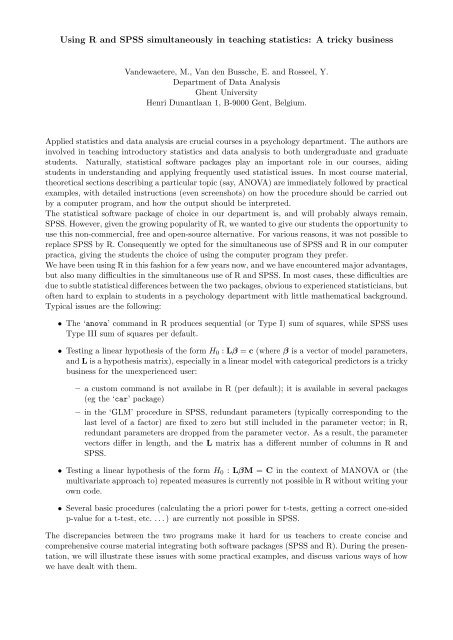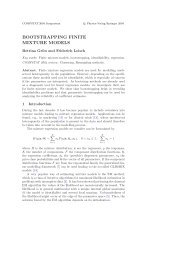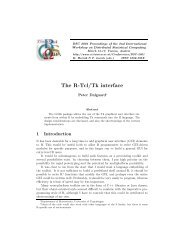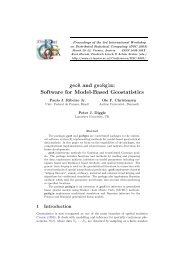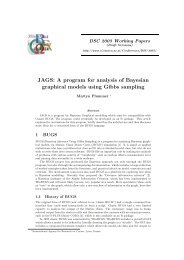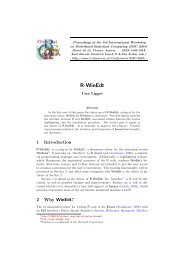Embedding R in Windows applications, and executing R remotely
Embedding R in Windows applications, and executing R remotely
Embedding R in Windows applications, and executing R remotely
You also want an ePaper? Increase the reach of your titles
YUMPU automatically turns print PDFs into web optimized ePapers that Google loves.
Us<strong>in</strong>g R <strong>and</strong> SPSS simultaneously <strong>in</strong> teach<strong>in</strong>g statistics: A tricky bus<strong>in</strong>ess<br />
V<strong>and</strong>ewaetere, M., Van den Bussche, E. <strong>and</strong> Rosseel, Y.<br />
Department of Data Analysis<br />
Ghent University<br />
Henri Dunantlaan 1, B-9000 Gent, Belgium.<br />
Applied statistics <strong>and</strong> data analysis are crucial courses <strong>in</strong> a psychology department. The authors are<br />
<strong>in</strong>volved <strong>in</strong> teach<strong>in</strong>g <strong>in</strong>troductory statistics <strong>and</strong> data analysis to both undergraduate <strong>and</strong> graduate<br />
students. Naturally, statistical software packages play an important role <strong>in</strong> our courses, aid<strong>in</strong>g<br />
students <strong>in</strong> underst<strong>and</strong><strong>in</strong>g <strong>and</strong> apply<strong>in</strong>g frequently used statistical issues. In most course material,<br />
theoretical sections describ<strong>in</strong>g a particular topic (say, ANOVA) are immediately followed by practical<br />
examples, with detailed <strong>in</strong>structions (even screenshots) on how the procedure should be carried out<br />
by a computer program, <strong>and</strong> how the output should be <strong>in</strong>terpreted.<br />
The statistical software package of choice <strong>in</strong> our department is, <strong>and</strong> will probably always rema<strong>in</strong>,<br />
SPSS. However, given the grow<strong>in</strong>g popularity of R, we wanted to give our students the opportunity to<br />
use this non-commercial, free <strong>and</strong> open-source alternative. For various reasons, it was not possible to<br />
replace SPSS by R. Consequently we opted for the simultaneous use of SPSS <strong>and</strong> R <strong>in</strong> our computer<br />
practica, giv<strong>in</strong>g the students the choice of us<strong>in</strong>g the computer program they prefer.<br />
We have been us<strong>in</strong>g R <strong>in</strong> this fashion for a few years now, <strong>and</strong> we have encountered major advantages,<br />
but also many difficulties <strong>in</strong> the simultaneous use of R <strong>and</strong> SPSS. In most cases, these difficulties are<br />
due to subtle statistical differences between the two packages, obvious to experienced statisticians, but<br />
often hard to expla<strong>in</strong> to students <strong>in</strong> a psychology department with little mathematical background.<br />
Typical issues are the follow<strong>in</strong>g:<br />
• The ‘anova’ comm<strong>and</strong> <strong>in</strong> R produces sequential (or Type I) sum of squares, while SPSS uses<br />
Type III sum of squares per default.<br />
• Test<strong>in</strong>g a l<strong>in</strong>ear hypothesis of the form H 0 : Lβ = c (where β is a vector of model parameters,<br />
<strong>and</strong> L is a hypothesis matrix), especially <strong>in</strong> a l<strong>in</strong>ear model with categorical predictors is a tricky<br />
bus<strong>in</strong>ess for the unexperienced user:<br />
– a custom comm<strong>and</strong> is not availabe <strong>in</strong> R (per default); it is available <strong>in</strong> several packages<br />
(eg the ‘car’ package)<br />
– <strong>in</strong> the ‘GLM’ procedure <strong>in</strong> SPSS, redundant parameters (typically correspond<strong>in</strong>g to the<br />
last level of a factor) are fixed to zero but still <strong>in</strong>cluded <strong>in</strong> the parameter vector; <strong>in</strong> R,<br />
redundant parameters are dropped from the parameter vector. As a result, the parameter<br />
vectors differ <strong>in</strong> length, <strong>and</strong> the L matrix has a different number of columns <strong>in</strong> R <strong>and</strong><br />
SPSS.<br />
• Test<strong>in</strong>g a l<strong>in</strong>ear hypothesis of the form H 0 : LβM = C <strong>in</strong> the context of MANOVA or (the<br />
multivariate approach to) repeated measures is currently not possible <strong>in</strong> R without writ<strong>in</strong>g your<br />
own code.<br />
• Several basic procedures (calculat<strong>in</strong>g the a priori power for t-tests, gett<strong>in</strong>g a correct one-sided<br />
p-value for a t-test, etc. . . . ) are currently not possible <strong>in</strong> SPSS.<br />
The discrepancies between the two programs make it hard for us teachers to create concise <strong>and</strong><br />
comprehensive course material <strong>in</strong>tegrat<strong>in</strong>g both software packages (SPSS <strong>and</strong> R). Dur<strong>in</strong>g the presentation,<br />
we will illustrate these issues with some practical examples, <strong>and</strong> discuss various ways of how<br />
we have dealt with them.


